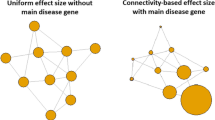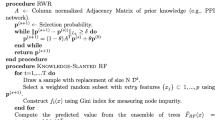Abstract
Prediction of differential essential genes is an important field to research cell development and differentiation, drug discovery and disease causes. The goal of this work is to extract gene expression and topological changes in biomolecular networks for identifying the essential nodes or modules. Based on the random forests model, this paper proposed an essential node prediction algorithm for biomolecular networks called Differential Network Analysis method based on Random Forests (DNARF). The algorithm had two main points. First, the five-dimension eigenvector construction method was put forward to extract the differential information of nodes in networks. Second, a positive sample expansion method based on the Pearson correlation coefficient was present to solve the problem that positive and negative samples may be unbalanced. In the simulated data experiments, the DNARF algorithm was compared with three other algorithms. The results showed that the DNARF had an excellent performance on the prediction of essential genes. In the real data experiments, four gene regulatory networks were used as datasets. DNARF algorithm predicted five essential genes related to leukemia: HES1, STAT1, TAL1, SPI1 and RFXANK, which had been proved by literatures. Also, DNARF could be applied to other biological networks to identify new essential genes.
Access this chapter
Tax calculation will be finalised at checkout
Purchases are for personal use only
Similar content being viewed by others
References
Yang, D., Parrish, R.S., Brock, G.N.: Empirical evaluation of consistency and accuracy of methods to detect differentially expressed genes based on microarray data. Comput. Biol. Med. 46, 1–10 (2014)
De la Fuente, A.: From ‘differential expression’ to ‘differential networking’–identification of dysfunctional regulatory networks in diseases. Trends Genet. 26, 326–333 (2010)
Ideker, T., Krogan, N.J.: Differential network biology. Mol. Syst. Biol. 8, 565 (2012)
Hudson, N.J., Reverter, A., Dalrymple, B.P.: A differential wiring analysis of expression data correctly identifies the gene containing the causal mutation. PLoS Comput. Biol. 5, e1000382 (2009)
Odibat, O., Reddy, C.K.: Ranking differential hubs in gene co-expression networks. J. Bioinform. Comput. Biol. 10, 1240002 (2012)
Chen, Y., Xu, D.: Understanding protein dispensability through machine-learning analysis of high-throughput data. Bioinformatics 21, 575–581 (2004)
Song, J., et al.: PREvaIL, an integrative approach for inferring catalytic residues using sequence, structural, and network features in a machine-learning framework. J. Theor. Biol. 443, 125–137 (2018)
Yeganeh, P.N., Mostafavi, M.T.: Use of machine learning for diagnosis of cancer in ovarian tissues with a selected mRNA panel. In: 2018 IEEE International Conference on Bioinformatics and Biomedicine (BIBM), pp. 2429–2434. IEEE, Madrid (2018)
Cutler, D.R., et al.: Random forests for classification in ecology. Ecology 88, 2783–2792 (2007)
Seidman, S.B.: Network structure and minimum degree. Soc. Netw. 5(3), 269–287 (1983)
Freeman, L.C.: A set of measures of centrality based on betweenness. Sociometry 40, 35–41 (1977)
Wuchty, S., Stadler, P.F.: Centers of complex networks. J. Theor. Biol. 223, 45–53 (2003)
Saramäki, J., Kivelä, M., Onnela, J.-P., Kaski, K., Kertesz, J.: Generalizations of the clustering coefficient to weighted complex networks. Phys. Rev. E: Stat. Nonlinear Soft Matter Phys. 75, 027105 (2007)
Glas, A.S., Lijmer, J.G., Prins, M.H., Bonsel, G.J., Bossuyt, P.M.: The diagnostic odds ratio: a single indicator of test performance. J. Clin. Epidemiol. 56(11), 1129–1135 (2003)
Chawla, N.V., Bowyer, K.W., Hall, L.O., Kegelmeyer, W.P.: SMOTE: synthetic minority over-sampling technique. J. Artif. Intell. Res. 16, 321–357 (2002)
Zhang, X.F., Ou-Yang, L., Yan, H.: Incorporating prior information into differential network analysis using nonparanormal graphical models. Bioinformatics 33, 2436 (2017)
Barabási, A.-L.: Scale-free networks: a decade and beyond. Science 325, 412–413 (2009)
Bockmayr, M., Klauschen, F., Denkert, C., Budczies, J.: New network topology approaches reveal differential correlation patterns;in breast cancer. BMC Syst. Biol. 7, 78 (2013)
Lichtblau, Y., Zimmermann, K., Haldemann, B., Lenze, D., Hummel, M., Leser, U.: Comparative assessment of differential network analysis methods. Brief. Bioinform. 18, 837 (2016)
Neep, S., Stergachis, A.B., Reynolds, A., Sandstrom, R., Borenstein, E., Stamatoyannopoulos, J.A.: Circuitry and dynamics of human transcription factor regulatory networks. Cell 150, 1274–1286 (2012)
Stergachis, A.B., et al.: Conservation of trans-acting circuitry during mammalian regulatory evolution. Nature 515, 365–370 (2014)
Sloan, S.A., et al.: Human astrocyte maturation captured in 3D cerebral cortical spheroids derived from pluripotent stem cells. Neuron 95, 779–790 (2017)
Hassannia, B., Wiernicki, B., Ingold, I., Qu, F., Berghe, T.V.: Nano-targeted induction of dual ferroptotic mechanisms eradicates high-risk neuroblastoma. J. Clin. Investig. 128, 3341–3355 (2018)
Harris, L.W., et al.: The cerebral microvasculature in schizophrenia: a laser capture microdissection study. PLoS One 3, e3964 (2008)
Mahdavi, M., et al.: Hereditary breast cancer; Genetic penetrance and current status with BRCA. J. Cell. Physiol. 234, 5741–5750 (2019)
Aygun, N., Altungoz, O.: MYCN is amplified during S phase, and c-myb is involved in controlling MYCN expression and amplification in MYCN-amplified neuroblastoma cell lines. Mol. Med. Rep. 19, 345–361 (2019)
Cai, L., et al.: ZFX mediates non-canonical oncogenic functions of the androgen receptor splice variant 7 in castrate-resistant prostate cancer. Mol. Cell 72, 341–354 (2018)
Desmots, F., et al.: Pan-HDAC inhibitors restore PRDM1 response to IL21 in CREBBP-mutated follicular lymphoma. Clin. Cancer Res. 25, 735–746 (2019)
Narayanan, A., et al.: The proneural gene ASCL1 governs the transcriptional subgroup affiliation in glioblastoma stem cells by directly repressing the mesenchymal gene NDRG1. Cell Death Diff. 1 (2018)
García-Martínez, A., et al.: DNA methylation of tumor suppressor genes in pituitary neuroendocrine tumors. J. Clin. Endocrinol. Metabol. 104, 1272–1282 (2018)
Wang, L., et al.: Kaiso (ZBTB33) downregulation by Mirna-181a inhibits cell proliferation, invasion, and the epithelial-mesenchymal transition in glioma cells. Cell. Physiol. Biochem. 48, 947–958 (2018)
Gao, Y., et al.: PPARα Regulates the proliferation of human glioma cells through miR-214 and E2F2. BioMed. Res. Int. 2018 (2018)
Davudian, S., Mansoori, B., Shajari, N., Mohammadi, A., Baradaran, B.: BACH1, the master regulator gene: a novel candidate target for cancer therapy. Gene 588, 30–37 (2016)
Roychoudhuri, R., et al.: The transcription factor BACH2 promotes tumor immunosuppression. J. Clin. Investig. 126, 599–604 (2016)
Blasi, F., Bruckmann, C., Penkov, D., Dardaei, L.: A tale of TALE, PREP1, PBX1, and MEIS1: interconnections and competition in cancer. Bioessays 39 (2017)
Lin, M., Lin, J., Hsu, C., Juan, H., Lou, P., Huang, M.: GATA3 interacts with and stabilizes HIF-1α to enhance cancer cell invasiveness. Oncogene 36, 4243 (2017)
De Bustos, C., Smits, A., Strömberg, B., Collins, V.P., Nistér, M., Afink, G.: A PDGFRA promoter polymorphism, which disrupts the binding of ZNF148, is associated with primitive neuroectodermal tumours and ependymomas. J. Med. Genet. 42, 31–37 (2005)
Richart, L., Real, F.X., Sanchez-Arevalo Lobo, V.J.: c-MYC partners with BPTF in human cancer. Mol. Cell. Oncol. 3, e1152346 (2016)
Rani, A., Greenlaw, R., Smith, R.A., Galustian, C.: HES1 in immunity and cancer. Cytokine Growth Factor Rev. 30, 113–117 (2016)
Kovacic, B., et al.: STAT1 acts as a tumor promoter for leukemia development. Cancer Cell 10, 77–87 (2006)
Brown, L., et al.: Site-specific recombination of the tal-1 gene is a common occurrence in human T cell leukemia. EMBO J. 9, 3343–3351 (1990)
Moreau-Gachelin, F., Ray, D., Tambourin, P., Tavitian, A.: Spi-1 oncogene activation in Rauscher and Friend murine virus-induced acute erythroleukemias. Leukemia 4, 20–23 (1990)
Das, B., Majumder, D.: Information theory based analysis for understanding the regulation of HLA gene expression in human leukemia. Int. J. Infor. Sci. Tech. (2012)
Acknowledgement
This work was partially supported by the National Natural Science Foundation of China [No. 61873156] and the Project of NSFS [No. 17ZR1409900].
Author information
Authors and Affiliations
Corresponding authors
Editor information
Editors and Affiliations
Rights and permissions
Copyright information
© 2019 Springer Nature Switzerland AG
About this paper
Cite this paper
Xie, J., Sun, J., Li, J., Yang, F., Li, H., Wang, J. (2019). A Novel Differential Essential Genes Prediction Method Based on Random Forests Model. In: Huang, DS., Jo, KH., Huang, ZK. (eds) Intelligent Computing Theories and Application. ICIC 2019. Lecture Notes in Computer Science(), vol 11644. Springer, Cham. https://doi.org/10.1007/978-3-030-26969-2_51
Download citation
DOI: https://doi.org/10.1007/978-3-030-26969-2_51
Published:
Publisher Name: Springer, Cham
Print ISBN: 978-3-030-26968-5
Online ISBN: 978-3-030-26969-2
eBook Packages: Computer ScienceComputer Science (R0)




